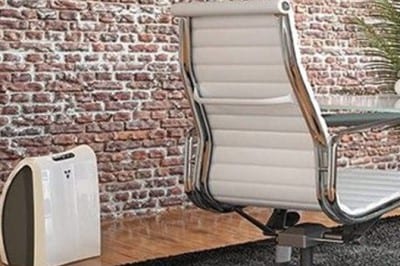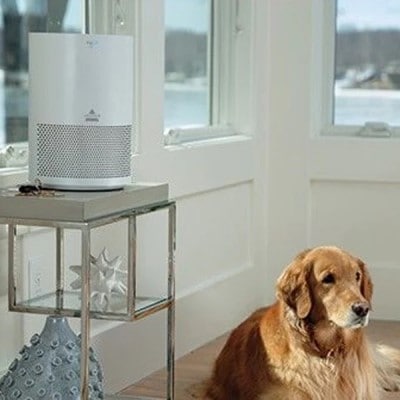What to Look for When Buying an Air Purifier
Posted on May 10, 2020 By PC Richard Staff
Air purification in the home and office is becoming quite popular thanks to better, more affordable and more efficient air purifiers hitting the market in recent years. It makes sense the trend is growing given there are many benefits to maintaining cleaner air in your home and workspaces. Even the most cautious individuals often overlook the quality of the air they breathe and the impact it has on their well-being. Luckily, there are many easy-to-use air purifiers that will leave your home's air cleaner, leading to a healthier, more comfortable lifestyle for you and your family. With all the options and evolving filter technologies, it can be hard to determine what to look for. Here is some helpful information to prepare you for your decision.
Why is Air Purification So Important?
Surprisingly, no matter how clean you keep your home, the air inside will likely be polluted with pet hair, dust, dander, and even smoke particles that accumulate over time. This build-up of pollutants exacerbates health issues, causes unpleasant odors, and leaves a general feeling of "staleness" in the air that can be hard to ignore. With the advent of air purifying technology, we finally can overcome these issues and introduce fresh air back into our homes. By utilizing state of the art air filtration technologies, purifiers pull stagnant, polluted air into multi-stage cleansing chambers where the air is then forced through an intense HEPA filtration system, removing most contaminants, and then sent back into the room for you to enjoy. There is a noticeable difference in breathing cleaner air, especially over time. Many experience fewer respiratory ailments and reduced allergy symptoms, not to mention reduced odors and fresher smelling air.
What's the Difference between HEPA Type and True HEPA Filtration?
When it comes to air purifiers, nothing is more important than the type of filter or multiple filters that they use. Air purifier filters, otherwise known as High-Efficiency Particulate Air filters, are among the best current air purifying technology has to offer. Within the HEPA family, two main types of HEPA filters dominate the market: HEPA Type and True HEPA. While both filters share similar names, they differ significantly in efficiency, density, and pricing.
True HEPA filters offer the best possible performance of any available filter. A True HEPA filter has an efficiency rate of 99.97%, meaning it can capture particles as small as 0.3 microns in size. To put that in perspective, a single red blood cell is 5 microns in size, nearly 5 times larger than the smallest particle a True HEPA filter can pick up. This purification can be pushed even further with a Premium HEPA filter, where the efficiency rates can reach as high as 99.99% and capture particles at 0.003 microns in size. That's 100 times smaller than a standard True HEPA filter can manage.
When it comes to HEPA Type filters, these are the more affordable, less efficient siblings of True HEPA filters. HEPA Type filters have a 99% efficiency rating or less, meaning they are capable of capturing particles as small as 2 microns in size. While HEPA Type filters are made from fiberglass just like True HEPA filters, the difference is that HEPA Type filters have a less dense composition, which may allow finer particles like germs to sneak by. Finally, HEPA Type filters are significantly more affordable than True HEPA filters, costing as much as 2 to 3 times less than competing True HEPA filtration products.

Purpose of UV-Light or Charcoal Filters
We know HEPA filters can capture germs and bacteria, but now what do we do with them? For most air purifiers, there are two options: a UV-Light or Charcoal Filter. The UV Light is the more advanced option. UV light can kill microorganisms such as germs and viruses, preventing them from reproducing and spreading further throughout your home.
Carbon filters, on the other hand, focus more on fumes and odors. A charcoal filter consists of millions of tiny absorbent carbon pores which excel at filtrating gases, chemicals and VOCs (Volatile Organic Compounds). This means carbon filters can remove foul-smelling odors and leave your home smelling fresh again.
Many air purifiers use a carbon filter and/or UV light in addition to the primary HEPA filter. This is called multistage filtration and is an indicator that the unit is equipped to remove more contaminants with each layer of filtration.
What is the CADR rating?
At long last, we arrive at CADR ratings. CADR stands for Clean Air Delivery Rate. A CADR rating provides consumers with numerical values which show how fast specific particles can be removed from the air. The speed at which the air purifier moves is taken in CFM, which stands for cubic feet per minute.
The higher the CFM, the faster your air purifier will cleanse out the pollutants. Larger areas will require higher CFM air purifiers to cleanse them efficiently, while smaller rooms can get by with lower CFM models with no problem. In newer models, you will find CADR ratings for Dust, Pollen and Smoke. This is helpful if you are trying to combat a specific type of contaminant. Use these ratings to determine how well it will work for your application. Remember, the higher the CADR, the better it is at doing its job. It's that simple!
Now that you know all about air purifiers, you should be ready to make a wise choice for purifying the atmosphere in your home to your needs.